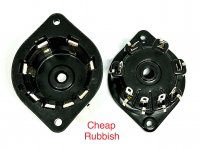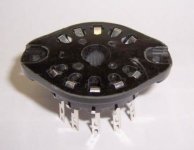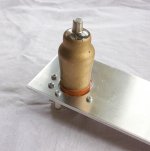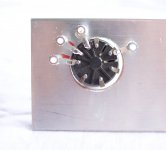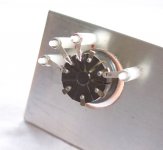Side contact sockets are clearly the work of the Devil - nobody else could have conceived of a more evil creation. They destroy tubes for a start, as you endeavour to get them in or out - look at how many have loose bases.
And then...... some of them just don't work, period. Can't get a tube in. Unfortunately I bought a batch of such sockets - shiny and probably Chinese with a small hole at the bottom. Complete rubbish.
I need some of these sockets, so can anybody point me to some that actually work reliably?
And then...... some of them just don't work, period. Can't get a tube in. Unfortunately I bought a batch of such sockets - shiny and probably Chinese with a small hole at the bottom. Complete rubbish.
I need some of these sockets, so can anybody point me to some that actually work reliably?
Attachments
Work of the devil
I won’t disagree
They destroy tubes for a start, as you endeavour to get them in or out - look at how many have loose bases.
This is no fault of the socket , rather what part of the valve you choose to hold to insert/remove.
I.e. hold the base, not the glass
I won’t disagree. This is no fault of the socket , rather what part of the valve you choose to hold to insert/remove.
I.e. hold the base, not the glass
Well, obviously you don't hold the glass unless you're completely new to side contact valves (!!!). But the most reliable way to get the damn valves out is 2 screwdrivers with small heads - one on either side. You prise the valve up by pushing down on the ends of the 2 screwdrivers simultaneously. Do this over something soft, not on the kitchen table where the valve can spring out and crash onto the floor.
The trouble with the Chinese sockets is you can't even get the valves in them.
I bought a couple of sockets to try them out, and have had a similar experience. I could not even get one socket to take the tube. I compared with a socket in an old PA amp, and it was a much more pleasant experience to insert and remove the tube.
As far as I can tell, the CT base will fit inside a bakelite 0ctal tube base, which can be had cheaply and are reasonable quality, so I am thinking I'll permanently fit the tube in the octal base, wiring the side contacts to the octal pins.
Most CT tubes had an octal equivalent, so it is more of a rebadging exercise than tube desecration.
As far as I can tell, the CT base will fit inside a bakelite 0ctal tube base, which can be had cheaply and are reasonable quality, so I am thinking I'll permanently fit the tube in the octal base, wiring the side contacts to the octal pins.
Most CT tubes had an octal equivalent, so it is more of a rebadging exercise than tube desecration.
Well, obviously you don't hold the glass unless you're completely new to side contact valves (!!!). But the most reliabl
Obvious to you and me but…
Obvious to you and me but…
Too true....
I think these Chinese sockets were wrongly measured when they set up the tooling. My only explanation is that the insides of the sockets are slightly narrower. So the little springs for the contacts don't have any travel in them, and just jam up. I had a close look and I'm pretty sure that's the problem.
I took one or two contacts out to see if that would ease the tightness, and it did show some promise, though the valve didn't sit level and was lopsided.
Surely the people selling these must know that they don't work properly?
I have a small number of vintage sockets which work fine, but I need some more. Any going spare?
Andy, I have some original Telefunken sockets from the 40er / 50er years if you are interested. Send me a PM.
Amazed anybody would voluntarily use such obsolete and problematic Technology.
What would be the "advantage" ???????
Yes, I read the blurb about "silky sound" 🙄
Anything more ..... "substantial"????? 😕
What would be the "advantage" ???????
Yes, I read the blurb about "silky sound" 🙄
Anything more ..... "substantial"????? 😕
Interesting and cheap tubes, like AZ1, AZ4, AL4, AL3. Looking at the Vintage Radio site, it is quite common to source hard to find octal or German Y8A tubes as the CT equivalent, then wire an adaptor.
Last edited:
I agree. A ceramic (UX4 or UX5) is much better than those obsolete phenolic sockets.Amazed anybody would voluntarily use such obsolete and problematic Technology.
What would be the "advantage" ???????
Yes, I read the blurb about "silky sound" 🙄
Anything more ..... "substantial"????? 😕
Side contact sockets ....could have conceived of a more evil creation.
I don't think you got the message yet.
Those crap sockets were phased out in the 1930s precisely because they were no good then and gave bad contacts all the time.
The first replacements were the 7 pin "ux types" found in AC-Pen etc which were all for 4 volt heaters, and often had metallised conducting film on glass.
When they standardised the octal socket with spigot a sigh of relief must have been breathed by everyone (after the pretty poor 9 pin EF50 loctal).
The 8 pin loctal is still pretty OK from ex mil stock as are the old stock mil spec octals.
Anything else from China, B4 & B5 (KT8C) I wouldn't touch with a bargepole.
side contacts....what a load of old rubbish they were.....
I don't think you got the message yet.
Those crap sockets were phased out in the 1930s precisely because they were no good then and gave bad contacts all the time. Side contacts....what a load of old rubbish they were.....
I totally agree! The worst ever socket.
I swore I'd avoid them but there just happen to be some nice tubes I've been buying like the AZ1 mesh which I love for preamps. So over time I've collected tubes that use the side contact sockets. When the sockets work OK you can get some nice sounds from these old tubes.
The G10A Stahl sockets, on the other hand, were really nice to use. Unsafe, since they weren't shrouded, but I guess tubes were always enclosed in equipment in the 30s. B5 and B7 sockets were OK too, though the current Chinese ones yet again have exposed contacts.
Attachments
Last edited:
The new Chinese socket contacts are not the right material (for the job) and to compensate for their lack of spring are made with a more open angle to give equivalent pressure against the tube contact. The problem of course is that the dimension is not correct and the initial fit way too tight.
In addition to that, the batch I got have very poor quality plastic cups that fracture under the stress of inserting a tube into the too rigid contacts.
My workaround was to pre-compress the contacts with needle nose pliers. Out of eight tubes, four worked. The other four had intermittent contact and needed a better fix. Solder them to a board!
Yamamoto makes a side contact socket that is probably superb, if a little luxuriously priced.
In addition to that, the batch I got have very poor quality plastic cups that fracture under the stress of inserting a tube into the too rigid contacts.
My workaround was to pre-compress the contacts with needle nose pliers. Out of eight tubes, four worked. The other four had intermittent contact and needed a better fix. Solder them to a board!
Yamamoto makes a side contact socket that is probably superb, if a little luxuriously priced.
The new Chinese socket contacts are not the right material (for the job) and to compensate for their lack of spring are made with a more open angle to give equivalent pressure against the tube contact. The problem of course is that the dimension is not correct and the initial fit way too tight. My workaround was to pre-compress the contacts with needle nose pliers. Out of eight tubes, four worked. The other four had intermittent contact and needed a better fix. Solder them to a board!
.
I was also thinking to solder the tubes to a board. It's one solution that should guarantee good contact. I had a look at some possibilities and I can see a good way of doing this with hexagonal nylon spacers and solder tags. For the tubes I'm interested in I only need 4 contacts.
The alternative is to fiddle around with the Chinese sockets, which is pretty hit and miss, or spend money on vintage ones. As you found, the contact remains pretty erratic on these Chinese junk sockets. A miserable execution of a miserable design.
Last edited:
I don't think you got the message yet.
Those crap sockets were phased out in the 1930s precisely because they were no good then and gave bad contacts all the time.
The first replacements were the 7 pin "ux types" found in AC-Pen etc which were all for 4 volt heaters, and often had metallised conducting film on glass.
This is not quite right.
The side contact base was introduced in 1934 by Philips. The UX7 base dates from 1933. For some tube types with UX7 base and their years of introduction, see: UX7 @ The Valve Museum
The AC/PEN was introduced in 1930, albeit not with an UX7 base yet. The UX7 version was introduced in 1933. See: AC/Pen @ The Valve Museum
Philips stopped introducing new tube types with side contact bases in 1940 (the ECH4 was one of the last) and changed to Loctal for some years, followed by the Rimlock base in the second half of the 40's.
Philips never introduced new receiving tube types with UX7 bases after they stopped with the side contact base. After 1940 you rarely saw the introduction of new tube types with 4 Volt heaters (an exception being the AZ41 double rectifier with Rimlock base).
Correction: According to Radiomuseum.org the UY3, which has a side contact base, was introduced in 1948: UY 3, Tube UY3; Rohre UY 3 ID666, Half-Wave Vacuum Rectifier
well my experience dates from genuinely working on an old British set of the 1930s, so I might know a bit about it.This is not quite right.
The thing used the 7 pin bases with the good old gold film stuff on the RF part.
All 4V set, so we managed to date it somewhere around 1933-1935.
When I bought it (from a scrap yard for 50p), it motorboated so I had to change quite a few capacitors.
The speaker was a field coil type, and never gave trouble.
I spent plenty of time realigning all the IF transformers, and it then ran 12hrs a day for about a decade, with not the slightest hint of weakening.
It had LW, 2 bands of SW and MW all on the dial, and worked perfectly on all of them.
That set had a SIDE CONTACT tuning eye, which I simply could not replace - as it was already way unobtanium back in the 1970s.
So, I simply got rid of the side contact thingy, and stuffed an octal EMxxx in it's place with a 6.3V heater instead, and stuffed a little spare heater transformer in there to make it work.
I'm really not interested in people trying to give me lessons about stuff I have already worked on decades ago, well before quite a lot of people on this forum were born.
Sadly I think my mum junked the thing for some weird reason, probably in an alter ego day, of pre-dementia lunacy, like all my dad's brand new Mullard EL34s and lots of the other now rather expensive stuff 🙁
Having a dad who worked at the Mitcham factory meant you got the inside story on all of it, and lots of spare parts to play with as a kid, when everyone and their dog were swearing transistors were gonna make valves totally obsolete.
Possibly you might know a bit about it but the part I quoted from your earlier post was not quite right nonetheless.
I based my comment on sources. Do you have any source(s) for your comment?
Addition: A source for 1934 as the year of introduction of the side contact base (see page 35): https://www.radiomuseum.org/forumdata/users/1084/file/Monatsheft_13_Maerz_1934.pdf
I based my comment on sources. Do you have any source(s) for your comment?
Addition: A source for 1934 as the year of introduction of the side contact base (see page 35): https://www.radiomuseum.org/forumdata/users/1084/file/Monatsheft_13_Maerz_1934.pdf
Last edited:
I have a fix! See photos. It's a bit more time consuming but it's a relief to be rid of these awful sockets. What I found is that the pins on the valve base actually won't solder, but fortunately the round lug that holds the pins will solder normally. This is actually good news because when unsoldered the valve should return to its previous state. I tested it out on the filaments of a valve I have and that worked fine.
What do you think?
What do you think?
Attachments
- Home
- Amplifiers
- Tubes / Valves
- Side contact sockets that actually work?
